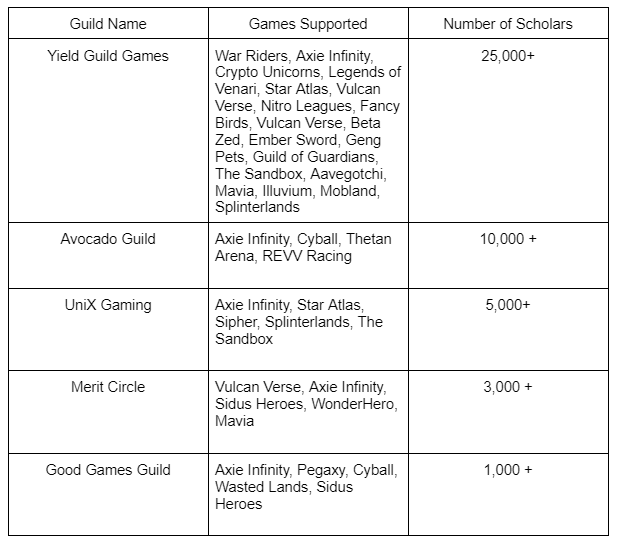Why have guilds exploded in the Web3 space recently?

Why have guilds exploded in the Web3 space recently?
Over the past couple of years, there has been an increase in the uptake of blockchain gaming — play-to-earn (P2E). The reason for this is that many people have been able to earn crypto and in some cases create a viable income by playing games from home. While, in rare cases, great fortunes have been made, P2E has had its fair share of issues.
Most P2E crypto games require an initial investment in the form of an NFT, many of which — especially for more popular and well-established Web3 games — are prohibitively expensive. That’s where gaming guilds become useful.
Why and how did guilds become popular?
First and foremost, what are gaming guilds and what do they do? Simply put, gaming guilds are the meeting point of investors and gamers. Within a guild, these two groups work together to earn profit from blockchain games. Investors own the digital assets, while gamers utilize them by playing the game.
There’s one clear advantage provided by gaming guilds — they offer players a new way to earn by playing Web3 games without having to buy any assets of their own. This concept has introduced an entirely new category of gamers known as “scholars”. The term scholars refers to gamers who want to play and earn but don’t have the required capital to make an initial investment. They effectively transfer the risk of asset devaluation from the players to the guild.
All assets used by scholars are owned by the guild. In order for this symbiotic relationship to function, profit from the game is split between the two parties with different ratios across the various guilds. Scholars generate revenue by playing and the profits are divided on an equity share basis.
Below are some of the most popular gaming guilds, some of the games they support, and the number of active scholars.

Gaming guilds didn’t just remove the barrier to entry for crypto gaming, they enabled the mass adoption and onboarding of millions of new players. Their presence was essential, not only for the scholars but for the games and their communities. Without the help of gaming guilds, crypto gaming probably wouldn’t have taken off with quite the momentum it did. Thanks to guilds, players can get in on the ground floor and acquire NFTs of their own by simply playing. This new gaming structure has paved the way for the wide adoption of digital assets in the Web3 economy.
What are the different guild models?
While most guilds follow the formula of lending assets to scholars and then splitting the revenue with them there are some different models worth examining.
Yield Guilds
These guilds focus on making the most revenue with their investment and allow:
- Purchasing digital assets (NFTs)
- Lending them to scholars
- Splitting the revenue with the scholars
- Reinvesting earned assets to further increase returns
Yield guilds often use their network of scholars to get better deals from upcoming games. These guilds usually have a set of tools that automate the onboarding of new scholars, lend assets and calculate the revenue. In addition, scholars receive coaching, meaning that their performance usually surpasses that of regular players. This helps deliver much much higher returns.
While this model brings a lot of initial liquidity and users to a new title, they aren’t great for long-term sustainability due to their overwhelming influence. Yield guilds seek to extract as much value as they can from a game. This conflicts with the philosophy of blockchain gaming whereby the main goal is long-term sustainability.
Investment Guilds
What makes this type of guild different is reinvestment in private sales and new games. They still have scholars but take a longer-term view of generating profit. Investment guilds are much closer to investment funds that maximize profit by managing the assets they own, instead of extracting value from scholar revenue.
This allows them to run scholars even at a negative if the guild believes the asset will rise in price in the future.
Value-adding Guilds
These guilds go a step beyond revenue. They might still have an investment fund combined with scholar elements but their main goal is to add value to an existing game. This might be done by delivering content, marketing, community growth, developing new tools and so on. By adding value to games, their idea is to build greater communities seeding the future for a healthy return on investment.
White-label solutions for guilds
The final category isn’t a gaming guild per se but is embedded enough within the space to be included in our run-down. Since we’ve seen the rapid growth of gaming guilds, it was only a matter of time before projects started to offer white-label solutions specifically designed for gaming guilds. These companies make the overall operations of a gaming guild easier by providing automation tools, data services, scripts and more.
What are the pros and cons of guilds and guild models?
Gaming guilds have revolutionized the blockchain gaming space. By removing the barrier to entry they’ve created the perfect conditions for the mass adoption of crypto gaming. Gamers no longer have to make an initial investment in order to participate in P2E — they can simply join a guild. This approach benefits not only the players but also the games they play and the wider Web3 gaming community.
One of the downsides of guilds is player volume. The number of players that apply for a scholarship is almost always higher than the scholarships available. This makes the process similar to applying for a job.
Another cause for concern in the business models described is the power guilds can exert over crypto games. In some cases, a gaming guild can even have a majority ownership of players playing and digital assets owned by those players. This imbalance conflicts with the democratic ethos underpinning most blockchain projects.
In addition, the withdrawal of such a powerhouse from a gaming ecosystem can have a catastrophic effect on the game’s economy and therefore its community. On the upside, guilds are unlikely to resort to these measures as their reputation would suffer.
Why Myria is partnering with high-quality guilds
Myria’s gaming blockchain has already onboarded some of the most anticipated Web3 games such as Meta Nomads and Psyber X. Aside from third-party games, Myria is also developing its own titles that are free-to-play.
Good games alone are not enough since it’s the community that drives a project forward. That’s why Myria believes guilds will play an even bigger role in Web3 gaming as the sector develops. This is one of the reasons the company is actively seeking new partnerships with the most reputable and recognized guilds in the space.
With over 150 projects already building their Web3 games on Myria’s L2 scaling solution, the company is raising the bar in the world of blockchain gaming. Tight collaboration with quality gaming guilds provides mutual benefit for Layer 2 operators, games developers, gaming guilds and their players. More than 1 million users have signed up and Myria’s community exceeds 300,000 members.
What does the future hold for guilds?
Web3 stands for community and gaming guilds represent that in its purest form. Without the players, there’d be no games and we’re well aware of that. That’s why gaming guilds are one of the most important elements of Web3 gaming. Millions of players will soon be joining guilds in order to play games without worrying about capital.
The future of gaming guilds in blockchain gaming is guaranteed. They represent a thriving community of like-minded individuals with a single goal — gaming. We foresee that gaming guilds will be one of the major players in the future of blockchain gaming, easily on par with game development studios and platforms. Imagine a company, driven entirely by a passionate community, that’s what gaming guilds are. All of that is already made possible with digital governance through guild DAOs. The future of gaming lies with the guilds.





Reviews